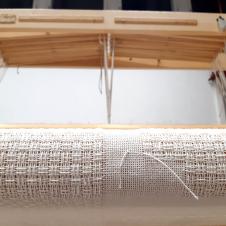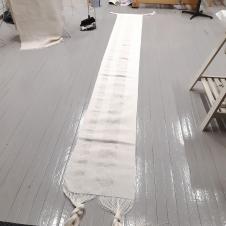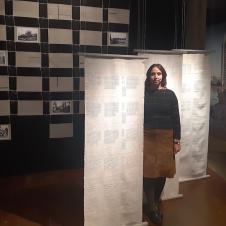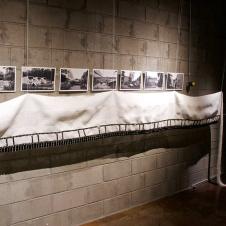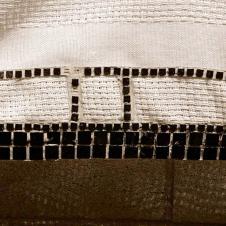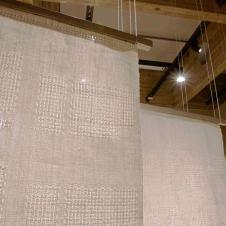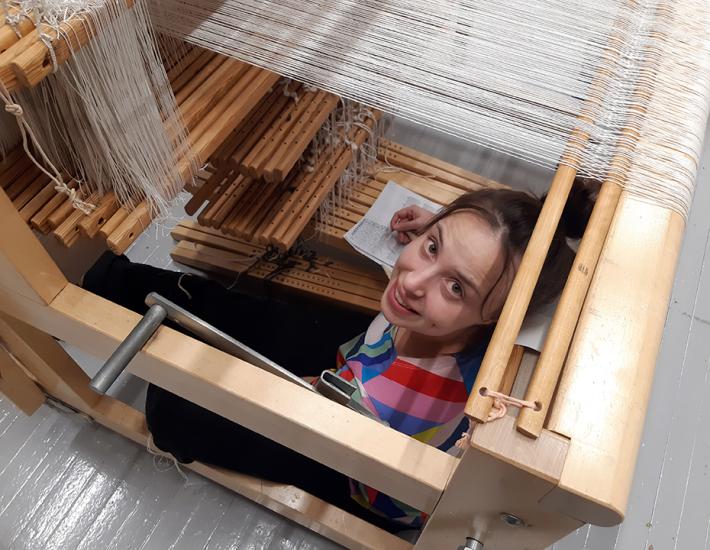
Hello Omnia Blogosphere! My name is Sophia, and I am a Canadian artist and weaver who recently collaborated with the Omnia Espoo Weaving Centre (Espoon työväenopiston kudonta-asema) to produce a new body of work in Finland. My installation-based practice explores the intersection between textiles and the built environment, with a particular interest in Modernist architecture and utopian urban design movements. From September to December 2022, I was in residency at the Ateljeesäätiö Tapiola Guest Studio, researching the history and development of the local architecture. This was the first time that a weaver has set up shop in the studio as part of the Québec-Finland residency exchange program, since it began in 1997.
I was fortunate to collaborate with the Omnia Espoo Weaving Centre, who lent me a beautiful Toika loom for the duration of the residency. It was a wonderful adventure and learning experience from beginning to end. I had the chance to pick up the deconstructed loom from storage and re-assemble it from scratch, learning how each piece of the mechanism interacts to serve its purpose. I visited the weaving centre for advice and instructions, and prepared my threads using the equipment available there. Over the course of three months, I wove over 16 metres of linen cloth, using a technique called Huck Lace.
Concurrently with preparing the weavings, I also had the amazing opportunity to engage with the community of Tapiola by collaborating with the Kampparit volunteer group of KAMU, Espoo City Museum. With the help of Senior Advisor Johanna Vähäpesola, we organized a walking tour and studio visit with members of Kampparit to share stories and perspective about the evolution of Tapiola over the years. Supported by these local connections with Omnia Espoo Adult Education Centre and Kampparit, I was able to prepare an installation entitled Prefab Arcadia: weaving architecture and utopia in Tapiola at the KAMU (espoo.fi) WeeGee lounge in early December. What follows is an alternate version of the text which accompanied the exhibition, which continued until January 15, 2023. More information about the exhibition (espoo.fi).
Prefab Arcadia responds to the history and development of Tapiola, global icon of postwar avant-garde architecture and "anti-urban urban planning". My work, as a whole, explores the social contexts and power structures surrounding architecture and urban development, using the unexpected combination of handwoven textiles with architectural construction materials. During my four-month artist residency in Tapiola, I have researched the garden city's utopian, socialist ideals in contrast to its evolution as a living community. What emerged were entangled themes such as wellness and normativity, consumerism and aesthetics, privacy and community-building.
Innovative prefabrication techniques born of post-war austerity were employed in the thoughtful architecture and landscape design of Tapiola's neighbourhoods. Through the original placement and orientation of windows and balconies, yards and forest paths, emerged new dynamics of gender, class, privacy, and relationship to nature.
However, Tapiola has also been criticized as an arcadia for the well-off, rooted in normative hetero-patriarchal values, and resistant to change. Although prefabricated towns are notoriously difficult to adapt as populations shift, Tapiola has evolved and sprawled for better or for worse. Informed by many, often contradictory, opinions about Tapiola, Prefab Arcadia attempts to weave a nuanced and ambiguous picture of a complex place.
In the spirit of paradox, Prefab Arcadia freely combines weaving with photography, concrete, tile, and prefabricated panels. Handwoven white-on-white linen textiles speak to Tapiola's “White Functionalist” style. Using the Huck Lace technique, semi-translucent designs on opaque grounds evoke windows, walls, and the spatial porousness of Tapiola. One traditional application of Huck Lace would be for window curtains that let in the light while offering privacy within.
Text and photos: Sophia Borowska
Sophia Borowska (sophiaborowska.com) is an artist and weaver based in Tiohtià:ke/Montréal, Canada. Her research delves into process and place, responding to specific sites through haptic and obsessive textile practices.
Borowska has exhibited across Canada and internationally, mostly presenting at artist-run centres and DIY, site-specific events. She has participated in residencies in Denmark and Québec. Borowska’s architectural approach to weaving has earned her grants and awards from institutions including the Handweavers’ Guild of America, Canada Council, CALQ, and SODEC.

